'Gerry Wedd, Kitschen (sic) Man' published in the Journal of Australian ceramics Vol 56 # 3, 2017
JamFactory ICON - Gerry Wedd ‘Kitschen Man’ – review of the 2016 touring exhibition.
Awarding the 2016 Nobel Prize for Literature to Bob Dylan was always going to be controversial, but things really ramped up given his tardiness in formally accepting the award. He did eventually fulfil his obligations by having the banquet speech delivered on his behalf by the US ambassador to Sweden, and then by finally giving his Nobel lecture, via satellite, just a few days short of the deadline that would have seen him forfeit 1.2 million dollars in prizemoney (now that really would have been controversial …) It was all a bit unconventional, but the committee probably should have remembered that this was the guy who went from roots folk icon to rock ‘n roll at Newport in 1965, reacting to a shocked audience by telling the band to … ‘play it fucking loud.’ At least he didn’t say that to the Nobel committee.
Both of Dylan’s speeches are now on the internet, and – again somewhat controversially – he is being accused of plagiarising some of the content from an online resource called Sparknotes, which should hardly be a surprise given that Dylan’s penchant for appropriation has underpinned a great deal of his recent output. The trick, and Gerry knows this better than most, is to borrow well, to do it in a way that pays back the debt.
I actually think that both of Dylan’s speeches are great insofar as they are very entertaining and, as an aside to the controversy surrounding his award, he does address the relative values that society places on art forms: high and low; the popular or the wilfully obscure; the good, the bad and the ugly.
In his banquet speech, Dylan says that he ‘ … began to think about William Shakespeare, the great literary figure. I would reckon he thought of himself as a dramatist. The thought that he was writing literature couldn’t have entered his head. His words were written for the stage. Meant to be spoken not read. When he was writing Hamlet, I’m sure he was thinking about a lot of different things. “Who are the right actors for these roles?” “How should this be staged?” “Do I really want to set this in Denmark?” … and … “Where am I going to get a human skull?”’.
Dylan goes on to say that his own creative process is just as riddled with questions that are often about the nuts and bolts that underpin making art, and that he hasn’t really had the time to sit back and ask himself if what he did counted as literature, but if the Academy had reached that conclusion then it was OK with him and he was grateful.
Bob Dylan deputised Patti Smith to perform in his stead at the ceremony and she forgot the words to ‘A Hard Rains Gonna Fall’ half way through the performance. More controversy, or just a storm in a teacup? In twenty, thirty, fifty-year’s time people won’t be talking about this stuff but they will still be listening to Bob Dylan. Art’s like that.
Anyone who knows Gerry and has seen him work will immediately get, at least in a general sense, why I mention Dylan, in that whenever Gerry is making the music is playing, but the way Dylan talks about process is also interesting because, at least in my experience, what ends up driving artists is the process of making – it’s the doing and not the done.
Gerry is a maker through and through, who can blend the personal and the private, high and low art, with enough technique to make it work but not too much that it becomes inaccessible, cut off from daily life. If Dylan is criticized for appropriating content then Gerry absolutely revels in re-using and reinventing the images that soak our daily lives; images that, even if we don’t necessarily want them to, inform our histories.
His 2016 Henry Lee Pot, based on Nick Cave’s rendition of the ballad ‘Henry Lee’, addresses various plot themes in different versions of the song, which has previously been called ‘Young Hunting’, ‘Poor Henry’, ‘Love Henry’, ‘Earl Richard’, ‘The Proud Girl’ etc., etc., etc. Gerry says he draws on the ‘narrative aspect of folk music and its potential for constant revision and reconfiguration’ as well as referencing the actual illustrations from material like old record covers and magazines. In addition, he often uses a pictorial device where this imagery is deliberately drawn in a manner that suggests a crude woodcut or linocut, whereas of course it’s nothing of the sort.
We think of this borrowing as being modern, the result (firstly) of the recording arts – photography, then film and sound – and then of post-modernism, but ceramics has a long history of appropriation. The Istoriato painters of sixteenth-century Italy wandered the Umbrian countryside as journeyman ceramic’s decorators, copying imagery from the woodcuts that were taken from paintings and deftly applying it to faience wares.
I’ve spent quite a bit of time watching Gerry work as a decorator and he has the ability to do what those Istoriato painters did; mixing invention with repetition, drawing on an enormous vocabulary of fragments gleaned from a bewildering variety of sources, turning out the work, making dreadful puns (“thong cycle” anyone?) and listening to music - always listening to music.
In Gerry’s ceramics the dark shadows of colonial history are balanced by the twang of guitars and the glitter of sun on the surf. There’s salt and frangipani, humility and humanity, the feel of sand between your toes and the hint of blood in the water.
I’m lucky to have seen some of the major works, in this exhibition of Gerry’s, being made in the studio at the JamFactory, and I even own a couple of the minor ones, which I’ll get to enjoy one day - after they finish being on the road.
Damon Moon
Adelaide 2017
Susan Frost
In her memoir Taken from the Back Row, Cosmopolitan.com editor Amy Odell describes being interviewed for a position as a fashion writer by the somewhat terrifying personage of Vogue's legendary editor, Anna Wintour.
Searching around for tips, Odell was informed that Wintour was 'all about colour', and so whatever she did she should avoid wearing black. In the end she chose to wear a cream dress and 'nude pumps', surely a term to conjure with. She didn't get the job, a career glitch which she puts down to getting almost all her answers to Wintour's questions wrong, but one has to wonder if the choice of a cream dress had anything to do with it. After all, nothing's that black and white.
Colour in ceramics has similarly been subject to fashions, as well as being dictated by technology throughout its long history. Who hasn't heard the term 'brown pots' being used somewhat disparagingly, although now the worm has turned, and brown is the new black. Studio pottery has seen various palettes come and go - Clarice Cliff, Grace Crowleyand Memphis were pretty gaudy, there was blue and there was white, and recently there was a period where everything white huddled together, perhaps an unwitting metaphor for contemporary politics. Colour can be a serious business.
By contrast, I would say that Susan Frost's work plays with colour, if play can indeed be this careful and considered. Taking her cues from various sources, including the faded hues of old Polaroids, and matching these to simple, domestic forms, she manages to achieve what seems to be limitless variations on a theme, with perfectly applied colour over perfectly formed Southern Ice. Her ceramics are at once contemporary and nostalgic, and one could imagine a photo shoot featuring picnic blankets and green grass and wicker baskets, especially if the photo was manipulated to mimic the old dye-transfer techniques. I drink my tea from one of Susan's cups every day. Its pale yellow and quite flawless, although according to Susan it's a second. Then again, she would say that, wouldn't she.
Damon Moon
Willunga 2015
Simple Virtues 'The Art of Function, the Function of Art'
In the early 2000s I was coming to the end of a curatorial project which involved chaperoning an international touring exhibition of contemporary Indonesian art around Australia. I had spent the last few years going to and from Indonesia, initially on an Asialink residency, researching, raising funds, and generally just doing whatever it took to get 'AWAS! Contemporary Art from Indonesia' seen by an audience in Australia, and subsequently in Japan, Germany and the Netherlands. AWAS! was a great show and well worth the effort but by the time it arrived at its final Australian destination at the Cairns Regional Gallery I'd had enough. On the first day in Cairns I did my back in trying to move a crate in the loading bay and for the next week I supervised the install, attended the opening and conducted the floor talks in considerable discomfort. Arriving back home in Adelaide I knew beyond a shadow of a doubt that I needed to relax, stop travelling as much and get back to basics, which for me has always been ceramics. It was also a period where a bit of self-reflection was in order, as the years I'd spent working with contemporary art had shown me that it was not a world I wanted to be immersed in as a permanent career.
Since I didn't feel ready to jump straight back into full-time making I decided to do a PhD in art history, looking at aspects of the development of Australian ceramics in the post war period. This was also a way of trying to make sense of my family history, to examine and order the experiences, people and images that had made up my childhood and see how they could be situated within the wider history of the crafts.
What could be easier, I thought? Lots of reading, a bit of writing (well, actually a couple of hundred thousand words of writing ending up as an eighty thousand word thesis with a thousand footnotes) three years of a university stipend - my God, I'd be so relaxed I could barely keep my eyes open.
Hmmmmm .......
Anyway, in the lead up to all of this, and despite the fact that I wanted to do the PhD purely by thesis, I began, in a very low-key manner, to make some pots. There were a few reasons for this, one being that my forays into the world of contemporary art had left me missing the simple act of making, and I do like making. Secondly, I began to explore the use of local materials in making functional work, as this philosophy was a part of the Leach/Cardew and subsequently McMeekin et al approach and this was something that informed my PhD research. It proved to be quite fascinating, and it was somewhat of a revelation to find out that that one could go for a drive in the hills with a pick and shovel and some empty buckets and sacks and collect useful, lovely materials with which you could make pots. Friendships were made with people that owned quarries, maps were marked with the locations of mineral deposits and wood ashes were sourced from different plants. It was like having a lovely hobby and the results - after several false starts - began to be worth the considerable effort this way of working entails.
Around this time I was contacted by the well-known chef and author Gay Bilson, who had just moved to South Australia after a high profile career in New South Wales, where she had variously run the restaurant at the Sydney Opera House and the famous Berowra Waters on the Hawkesbury River, a restaurant so exclusive that one had to access it either by boat or make a rather spectacular entrance by seaplane - as you do.
Gay was in Adelaide to work with the avant-garde American theatre director Peter Sellars, who had been appointed director of the 2002 Adelaide Festival of the Arts. Sellars, an eccentric figure who looked for all the world like a character out of an early David Lynch film, had promised a festival that would truly live up to the rhetoric of being cutting edge, innovative and challenging. Much to the concern of all involved it rapidly became apparent that he wasn't just saying this would be a festival like no other, but that he actually MEANT it. Sellars would eventually resign a few months before the festival opened leaving a large hole in the budget and a sort of anarchic cultural echo which has the effect of rendering every subsequent festival more predictable than the last, not that anybody notices in the midst of pop-up hipster venues and thousands of dreadful Fringe comedians.
As part of Sellar's proposed program food would play an important part in the proceedings, with a mix of events from gastronomic symposiums (rather like writer's week but with balsamic drizzle) to conceptual projects exploring the intersections of food and society. Gay - another person who definitely doesn't conform to expectations - came up with a project whereby she would supervise some meals for patients at local hospitals. She was looking for a potter to make work for several of these events and she ended up with me.
Two sets of work were finally made. Some plates for a symposium dinner and a couple of hundred small bowls for the hospital project and in the process of making these things I found a renewed passion for the functional, the simple, and the real. Not art, not 'Ceramics' with its capital C, just bowls and plates for food. Simple enough, or maybe not.
Jump forward thirteen years and I'm working as Creative Director of the Ceramics Studio at the JamFactory in Adelaide, where 2014 ended with us having made at least three thousand items for local restaurants and the domestic table. These were based on our 'Thrown' product range (featured in JAC Vol. 53 No. 3 November 2014 pages 78, 79) designed in house and made by local craftspeople in the JamFactory studios from local clays made by a local company and not, I repeat not, 'Made in China'.
In addition to all this activity, there has been one commission that I have been working on myself out of the Jam studios, for Scott Huggins and Emma McCaskill, the executive chefs at the Penfold's Magill Estate Restaurant, and it is this work that I want to end this article by discussing. Maybe it has something to do with the fact that they spent time working in Japan, where they were exposed to the the myriad aspects of Japanese ceramics, a far cry from the ubiquitous white-ware which 'plates up' so much Australian food. And there is also an element of fashion, where adventurous restaurants and cafes are more and more wanting to have individual, bespoke ceramics to match their food. There is also the fact that Scott and Emma, like many other chefs, are interested in the local, the seasonal and the variable, they want their ceramics to reflect this and by working with a potter they have the chance to explore textures, shapes and colours designed to really compliment the food.
Over the year, fitting it in with my other responsibilities and having more than a few failures along the way, I have been slowly making and supplying Magill Estate with nine sets each of thirty items for their degustation menu that are quite unlike any 'normal' white wares, and some of which might even push the boundaries of what is expected of hand-made ceramics for the kitchen or table. Using the ash from their kitchen braziers where they burn the pruning offcuts from Penfold's vineyards, to utilising hand dug kaolins which, when un-sieved, still contain feldspar and quartz inclusions, to plastic black, sodic clays gathered from the vineyards and olive groves that surround the little town where I live, I have tried to make work for them that is absolutely suited to their needs whilst truly reflecting the landscape, because it is from the landscape. I think we have similar aspirations, Scott and Emma and I, albeit in different fields, and I hope that the relationship will be ongoing, because nothing delights me so much as when they unexpectedly send through an image of food they have arranged on one of my - their - plates or dishes or bowls, so making it complete.
Honestly, who needs art?
Damon Moon
Willunga 2014
Published in the Journal of Australian ceramics Vol. 54 # 1 2015
Filthy Lucre: how money has helped to shape Australian ceramics over the past half century
“The best things in life are free
But you can keep them for the birds and bees Now gimme money (that’s what I want) ”
Nostalgia can be comforting, but it’s all too easy to wallow in a past that was really more like the present than one likes to think.
The Gordy/Bradford song was playing around the time Pottery in Australia was first published in 1962; Robert Menzies was Prime Minister, and EK Holdens were rolling off the production line, and tended to (forgive the tortured metaphor) paint a picture of Australian ceramics in, if not sepia tones, then at least colours reminiscent of an old Kodachrome slide. We think of it as being far removed from what happens now, but the reality is that only a few changes have occurred in Australian ceramics over the past five decades, and those changes, important though they are, are probably not the ones we expect to find.

For a start, not a lot has altered in the sort of work that is made. Ceramics can still be separated into the same categories of objects that it occupied fifty years ago; namely, vessel-based work and everything else. There may be a quibble about when ceramics becomes sculpture or at what point a pot becomes
a representation of a pot, but, for the purposes of this discussion, I’m contending that nothing new has arrived on the scene during the past half century.
We’ve had faux Sung and faux just about everything Japanese, Modernism, Funk, Memphis, Post Modernism, Cool Porcelain, Designer Groupings, Conceptual Clay and God knows what else. Even the seemingly recent innovation of installations date back at least to the mid-seventies.1 Some styles seem to have come and gone while others have endured, but perhaps the only really notable change in all that time has been a shift in interest away from brown clay, once the staple of Australian potters, to the almost universal use of white clays, particularly porcelain.
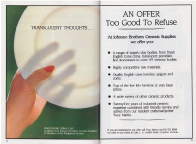
This preference for etiolation also touches on the question of techniques and materials, but again very little has actually changed. Earthenware pottery, once the mainstay of early Australian studio pottery, made quite a comeback in the 1970s and 80s, while the fetish for porcelain has continued to grow, making the wide brown land into the great Southern Ice-land. Although the use of more ‘natural’ materials has diminished, the woodfirers still show a significant commitment to a ‘back-to-nature’ approach, even if that means utilising pre-packaged and specially formulated clay that will react nicely to a three-day firing in an anagama. (And just trying to say “in an anagama” surely deserves some sort of prize.)
Shifting our attention to how ceramics is taught, it seems that here at least there have been some significant shifts, with the precipitous decline of ceramics as a discrete subject within the art curriculum being the most radical change of all. Nonetheless, what has remained constant is that the teaching of ceramics to adults has mainly been undertaken by tertiary institutions as part of the ‘higher education’ sector – bodies funded by the government that award qualifications of various sorts.
An unexpected consequence of this situation has been the proliferation of ceramicists who now possess higher degrees, but this says more about the way art schools have been incorporated into the university sector than it does about the work that is made. Universities are funded to do research and they take every opportunity to frame their activities within these guidelines, so if an art school is part of a university it is only reasonable to expect that some students will take matters to a logical academic conclusion.
There are several other possible approaches as to how ceramics might have been taught, but few of these met with any success. Despite some valiant attempts to set up government-funded apprenticeships, this approach never caught on, and privately funded apprenticeships were always destined to fail in a country where the teacher could hardly earn enough from the sales of work to support themselves, let alone a trainee. The other approach, where ceramics was taught as a genuine trade, wasn’t ever really a starter, since traditional ceramics manufacturers were dying out by the time the post war crafts movement had taken hold.
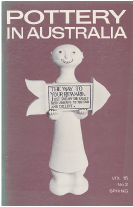
Despite this reliance on the art school system, the position of ceramics within the marketplace has always been more ambiguous, with goods appearing in venues ranging from high-end galleries to craft shops, private showrooms and even stalls in local markets. Sometimes a ceramicist would place work in all of these venues simultaneously, showing a promiscuous disregard for the niceties that constrained more mainstream artists and helped defined their practice.
Maybe the only consistent factor in Australian ceramics has been its continuing marginality; always one sandwich short of a picnic as far as the art world was concerned, and increasingly fated to be on the decline with a general public spoiled for choice in a modern consumer paradise. In fact, it is this last observation which points to the factor that has conditioned every aspect of the development of Australian ceramics, from the amateur to the professional, from academia to the marketplace, in both the public and private sectors, and that is money.
Money may indeed be the root of all evil2 (actually this is a malapropism – the original quote suggests that the love of money is the problem) but the economy of the crafts, how money is earned and distributed within a community of makers and consumers, has shaped Australian clay as surely as the hands of a skilled craftsperson.
To see how this has happened, we must go back to the late 1940s when legions of returned servicemen, aided by government funded retraining schemes, enrolled in courses in art schools and technical colleges throughout the country. Although ceramics was only a very small part of what was on offer it did allow some students to experience clay for the first time and to consider that some form of artistic expression could be a part of their lives.
In addition to this, the ending of the period of wartime austerity had led to a proliferation of small ceramics manufacturing concerns. The Australian public were hungry for goods, and potteries across the country sated the desire of the consumer for colourful, relatively inexpensive items that faced little domestic competition in a highly protected market. The work may have been earthenware, and some may have despised the seemingly endless supply of eggcups and ramekins that flooded the market, but it was a business with a sound economic base.
At the same time, growing numbers of Australian potters, inspired by Bernard Leach’s A Potter’s Book, embraced the challenges of stoneware. The aesthetic was different and the technology presented many challenges, which doubtless was part of the appeal and explains the tendency of ceramics magazines to include copious amounts of technical information. There was a ready market for this new style of work, as it fitted well with the more avant-garde trends in architecture and homewares, although whether it ever had the same level of mass appeal as earthenware is debatable.
Growing numbers of commercial galleries exhibited ceramics and, because of the good prospects for sales, commissions were low and galleries wouldn’t dream of charging up-front costs. Exhibitions often sold out, and there are wonderful stories of gallery directors rationing sales to eager customers, such was the interest in this new field of studio pottery. However, the major development in the ceramics economy concerned the increasing amounts of public money flowing to the crafts. There were two main sources of this extraordinary largesse.
The first was the proliferation of government-funded ceramics training courses. In departments of further education, in vocational training and at art schools, the 1960s and ’70s saw an exponential rise in the adult education sector. Since ceramics was often a part of the school curriculum, teacher training colleges incorporated ceramics departments as well.
The result was that by the mid-70s even a small state might have a dozen or more fully functioning ceramics departments scattered throughout the metropolitan and regional areas. Many of these institutions offered a range of courses, with part-time and after hours ceramics classes being very well attended indeed.
All of these departments needed to be staffed and equipped, and a reasonably talented ceramicist might well look forward to gaining at least some of their income from teaching, with the most fortunate ones being offered the sinecure of a tenured position, together with generous working conditions and the prospect of a highly subsidised superannuation scheme on their retirement.
We also shouldn’t forget the students who, thanks to the Whitlam years, now had access not only to free education but a student allowance that provided (just) enough money to live on, which led to ever greater numbers of people moving through the art departments.
If this era saw an expansion of the higher education sector, it also witnessed another facet of government support for the crafts, which was the introduction of the grant, or should that be the GRANT.
As Grace Cochrane notes:
“Towards the end of the 1960s, the first moves were made to rationalise and co-ordinate the ways in which the federal government funded the arts, a development that was to reach its fullest form in the reshaped Australia Council for the Arts in 1973.”3
The newly elected Prime Minister, Gough Whitlam, called on Jean Battersby, the CEO of the then Australia Council (originally an organisation mainly concerned with funding the performing arts), to prepare a report for the new government that highlighted the administrative and, from a strongly centralist government’s point of view, philosophical problems presented in overseeing the raft of existing arts funding bodies.4
Predictably enough, Battersby found that, “... the present situation is not satisfactory from an administrative point of view ...”5 To conjure the blessed spirit of Sir Humphrey Appleby, “steps needed to be taken”.
After all, Whitlam, with characteristic hyperbole, had stressed the importance of the arts to his new government, stating that,
“... all the other objectives of the Labor government – social reform, justice and equity in the provision of social services and educational opportunities – have as their goal the creation of a society in which the arts can flourish”.6
Never one to waste time, on Australia Day 26 January 1973, Whitlam announced the first appointments to a new arts council, comprising seven specialist boards, of which the Crafts Board was one. For the first time, the crafts had a seat at the adult table.
State governments followed suit, allocating funds through newly created departments of the arts to local crafts boards, which were often also funded by the Australia Council. Offices were rented, staff appointed and these organisations, state and federal, came to control the purse strings.
Not that the strings were drawn very tightly, at least in the beginning. Fiscal rectitude was not one of Gough’s strong points, and activities that had hitherto seemed to be the domain of the hobbyist – basket-weaving and the like – soon found themselves being encouraged and given financial support, and the mechanism by which this was achieved was the grant.
In an interesting historical coincidence, it was at about this time that the influence of a mainly American school of avant-garde ceramics, transmitted through the pages of that esteemed journal Craft Horizons, really began to be felt in this country.
This was a new type of ceramic work that was at the very forefront of post-modernism, revelling in its ‘dumbing down’ of high-art pretensions and poking fun at the rather serious and tasteful world of studio pottery. Unfortunately, these new ceramic objects were mostly unsaleable, and it is here that we begin to see the negative side of a system that supported artists to make things the public simply didn’t want.
This is such a complex equation that unravelling all the permutations should be the subject of at least one PhD. Suffice to say that the combination of providing government assistance for individuals to make work, together with rewarding many of those same individuals with teaching positions, as well as generously funding non-commercial gallery spaces to show work which was going to be very difficult to sell, led to a situation where many ceramicists didn’t take the attitudes of the general public into consideration at all, because they had no financial incentive to do so. This represented a paradigm shift in the relationship between Australian ceramicists and a public that had hitherto supported the crafts in a fairly enthusiastic manner.
There began an inevitable drift away from ceramics. Ceramics departments began to close down and the student numbers dwindled. The new management-driven class of education administrators (whose numbers were actually rising!) used this as an excuse to close more courses, and it just went on from there. Private galleries weren’t as willing to exhibit ceramics, because the sales had begun to drop off. They also charged a lot more for the privilege, regularly demanding up-front fees to cover costs, a punitive economic burden which the artist frequently tried to defray by – you guessed it – applying for a grant. Ironically, this practice was also adopted by government-funded spaces that found themselves in the privileged position of being paid (how shall I put this delicately?) to both give and receive at the same time.
Amidst all this discussion of the role of government in shaping Australian ceramics, what is to be said of the ultimate consumer, the so-called general public? What role have they played in all of this?
Tastes certainly do change, as does the availability of goods, and with it the way people choose to spend their money.
In the heyday of the crafts, inner-city shopping precincts barely had a coffee shop or restaurant to their name. Whole categories of modern consumer goods simply didn’t exist. This is significant because spending on the crafts is discretionary. The funds can just as easily be spent on something else, for example anything beginning with a lower-case ‘i’, or eating out.
Shops are now full of ridiculously cheap ceramics, mostly, but not exclusively imported from China, a country which has been pretty good at cornering a global market for export ceramics for over five hundred years. Whereas you simply couldn’t go into a store in the 1960s or ’70s and buy a nice set of plain white noodle bowls for a couple of dollars each, now you can get them at the supermarket. This is pretty serious competition for a potter who makes functional wares and it takes a very informed and dedicated consumer to spot the difference.
In the end, perhaps all one can really say is that in ceramics the distribution of government money
has had a definite impact on what is made, but then again so has the normal ebb and flow of the marketplace. The final arbiter of the arts economy is actually the secondary market, which is about as free as the free market gets, “... Nature, red in tooth and claw ...”7, though I don’t think Tennyson had Sotheby’s in mind when he came up with the phrase. It will probably take another fifty years to sort it all out.
Damon Moon
Willunga, 2012
- For example, Eros in Porcelain, an exhibition by the then Adelaide-based ceramicist Mark Thompson at the S.A. Craft Authority Gallery in May, 1976. A detailed review of this exhibition, written by Dick Richards, can be found in Pottery in Australia, Vol.15, No.2 p.66
- Timothy, chapter 6 verse 10
- Grace Cochrane, The Crafts Movement in Australia: a history, p.135 New South Wales University Press, 1992
- www.aph.gov.au/Library/pubs/BN/2008-9/ArtsPolicy.htm from a document prepared by Dr. John Gardiner-Garden 5 Jean Battersby, First Annual Report, January to December 1973 Australia Council for the Arts, 1973 p. 9
- Gough Whitlam, The Whitlam Government 1972–75, Viking 1985 p. 553
- Alfred Lord Tennyson, In Memorium A.H.H., 1850 (canto 55)
Gwyn Hanssen Pigott
“Instead, the things ... seep deliberately into one’s attention. They start vaguely, as little more than silhouettes, a vibration of one low colour against another. Gradually they ‘develop’ on the eye, and
one begins to grasp their internal relationships: how articulate the subtle sequence of tones may be,
in a form that once looked flat and brown; how many colours may be contained, as dusty hints and pearly afterimages of themselves, in what seemed to be a sequence of grey patches. If the straight side of a bottle seems to waver, it does so only to remind us how mutable and hard to fix the act of seeing really is. And if the shapes look simple, their simplicity is extremely deceptive; one recognises in it the distillation of an intensely pure sensibility, under whose gaze the size ... the silence of the motif and the inwardness of the vision are as one.”1
If not for the omission of six words in the passage above it might be assumed this article was one of the many recent tributes to the work of the late Australian potter Gwyn Hanssen Pigott, who passed away in London in July this year at the age of 78.
The missing words are ‘in his paintings’ and ‘of the painting’ and the 1981 essay by Robert Hughes is about the Italian painter Giorgio Morandi, an artist who profoundly influenced Hanssen Pigott’s work and to whom history may apply a similar judgement of being a petit-maître, an artist who “... although (they) said it very well, had only one thing to say”.2
These assessments will be made and contested over time, but it is true to say that the reputation of Gwyn Hanssen Pigott as Australia’s most significant, internationally recognised ceramicist, is predicated on a body of work that took one idea and, balancing a sound knowledge of her craft with an acute sensibility, parlayed that work into a career that I doubt she could ever have foreseen.
In contrast to the rather hagiographic tributes being written about her life in ceramics, Gwyn’s progress did not always chart a smooth and steady rise. Nonetheless, her beginnings in ceramics are not so far removed from where they ended, especially when one takes into account the myriad digressions that have characterised the field over the last sixty years.
Several factors influenced her early career. As a student of Fine Arts at the University of Melbourne she had ready access to the Kent Collection of Chinese ceramics at the National Gallery of Victoria, which at the time was the only readily accessible holding of historically significant Asian ceramics in the country. In an unusual but prescient move, Joseph Burke, then Head of Art History at the university, allowed her to research contemporary Australian pottery for her thesis. The Melbourne potter Harold Hughan introduced her to Bernard Leach’s A Potter’s Book, and so Leach’s persuasive arguments for the virtues of hand-made pottery, with its apotheosis in the ‘Sung standard’, could be immediately reinforced – ‘proved’ almost – by simply viewing the objects laid out before her in the gallery.
With Hanssen Pigott’s vision of ceramics having been realised (almost before it was formed) by the timeless beauty of classical Chinese wares, she quickly navigated the sea of rambunctious and gaudy earthenware that dominated Australian ceramics until “a very young nineteen-year-old in a dirndl skirt”3 arrived at the Sturt craft workshops in New South Wales where she met the potter Ivan McMeekin. There would be no turning back.
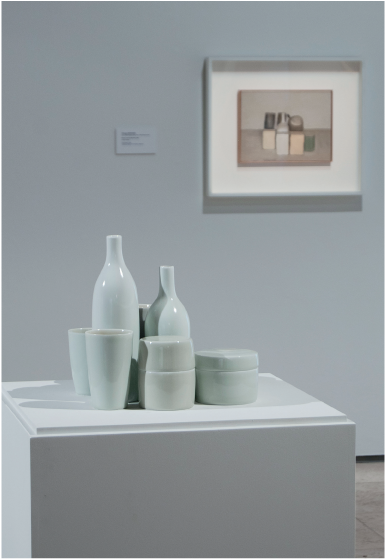

For Ivan McMeekin, who spent time in China before studying in England with Leach and Michael Cardew, the ‘Sung standard’ was accepted without question. When McMeekin returned to Australia from England to set up the ceramics workshop at Sturt, he sought to reproduce as closely as possible the classic wares of China, despite being separated from that originating culture by vast stretches of time and distance, and perhaps even of need. But McMeekin was tenacious and utterly convinced of his path and where he single-mindedly led, his young student followed. She took pressure off McMeekin by assuming responsibility for some of the teaching at Sturt, helpfully translating from the French the letters of the seventeenth-century Jesuit missionary Pere D’Entrocolles concerning Chinese porcelain manufacture, while digging for clay amongst the gum trees of the Southern Highlands in New South Wales.
When, with McMeekin’s blessing, she went to England in the late 1950s, Gwyn Hanssen Pigott set about furthering her education in ceramics at a time when Bernard Leach was the dominant figure and when his early apprentices were now leaders in their own right. Despite her commitment to this rather conservative approach to studio pottery, she also brushed up against a gentle version of modernism in London, where potters like Lucie Rie and Hans Coper had brought a ‘Continental’ sensibility to the field.
Gwyn Hanssen, as she was then, began to make a name for herself in London. Contemporary commentators remarked on her work as being “... completely acceptable ... a potter’s potter ...” 4 whose work “... more or less summarises the Leach-Cardew-Davis-Finch field ... akin to the work of the Mackenzie’s in the USA and McMeekin in Australia”.5 Pottery that belonged to the tradition of “Workshop potters versus art school potters. Useful-ware potters versus sculptor-painter-potters”6, this last observation having particular resonance when viewed in the light of her later work.
A typical example of her output at the time, from a 1962 exhibition at Primavera gallery in London, was almost a craft cliché: a ‘punch set’ consisting of cups with handles, a large, footed bowl and a ceramic ladle, all in muted, ash-glazed stoneware. And although Alison Britten, writing of this period in her essay ‘Gwyn Hanssen Pigott: a view from her second home’7, recalls that she represented a “... benchmark of sound and sensitive practice ...”8, other commentators had a different view, with Robert Melville, writing a few years earlier in Architectural Review, remarking that much of the ceramics coming out of the crafts movement seemed to belong to a “... village and market town community of highly aesthetic peasants ...”9
Gwyn Hanssen Pigott would soon reinforce this commitment to tradition (and here the word ‘tradition’ needs to be understood as being as much notional as factual) and by the mid-sixties, inspired by the simple beauty of French domestic pottery, she had settled in the district of Haut-Berry a few hours south of Paris. She built a large woodfired kiln and used local materials in a direct extension of McMeekin’s purist methodologies, which he in turn had inherited from Leach. (In truth, Leach was quite willing to modify his purist approach for the sake of expediency – it was more the early students like Michael Cardew and Harry Davis who took some of his philosophical urgings to what can only be described as fanatical extremes.)
She made pots in France and travelled often to England, where she supplemented her income by teaching at various art schools. Gwyn Hanssen Pigott had become a highly regarded maker of functional pottery, as good as any in the business. She was also very aware of the contradictions and paradoxes that ran through this modern, largely middle-class obsession with traditions that had faded away, when as early as 1969 she wrote that “... we younger potters ... can never be ‘potters of Haut-Berry’ ... we can never recapture the spirit that has passed. We remain, as ever, our immigrant selves, alone always, our work our own personal struggle and delight”.10
Later she recalled that she had “... tried ... to make something which would be real. I hoped that if I lived like a traditional potter somehow I would make pots like those unpretentious craftsmen in times gone by. But in fact I wasn’t unpretentious at all – nor simple ... I was acting a part that I hadn’t the strength for, and I was caught in a very subtle ambition to which I saw no end”.11
What is apparent from this statement is that Hanssen Pigott already had the ability to see beyond the objects she was making in order to interrogate their place in the world and, by extension, to question her own role as a contemporary craftsperson. This ability (which is rarer than one might think) does not necessarily lead to comfortable conclusions, and it probably contributed to her decision to leave her “... French idyll taking only what I could carry in my bag”.12
In 1973 Gwyn Hanssen Pigott returned to Australia. She worked for a while in New South Wales, and in 1974 moved to Tasmania where, with her student and future husband John Pigott, she established
a pottery near Hobart. During this time she returned to the methodologies that had characterised her work in France, making functional ceramics from locally sourced materials. The curator of Hanssen Pigott’s 2006 retrospective exhibition at the National Gallery of Victoria, Jason Smith, states that this time shows her “starting again”13, but she was also repeating herself, just in another place.
Her move in 1980 to the JamFactory workshops in South Australia resulted in a more substantial shift in her working practice, in that she found a way by which the effects she sought could be achieved more efficiently, albeit without any significant alteration to the final product. As ever, change in Hanssen Pigott’s work came incrementally. Change in location happened more frequently.
In 1981 she moved to Brisbane, becoming a resident potter at the Kelvin Grove campus of what is now the Queensland University of Technology. Over the next eight years, Hanssen Pigott continued to make functional pottery, even pursuing the decorated surface before “... reinvesting in simplicity ...”14
If functional, production-based pottery had maintained a certain cachet during the sixties and seventies, by the 1980s its allure was wearing a bit thin. The challenges first mounted on the Leach- derived studio pottery tradition by modernism and the Funk movement had evolved into a myriad of divergent styles; all clamouring for attention, all given equal time within the ceramics community, all suffering from the same lack of critical analysis that typified the discourses surrounding the Crafts and – with one or two possible exceptions - all being ignored by those working in the fine arts.
Working in the environment of an art school, the widening rift between ceramics made as art and studio-pottery was apparent. As Jeff Shaw, then Head of Kelvin Grove CAE, wrote of a 1983 exhibition of Hanssen Pigott’s work at Blackfriars Gallery in Sydney: “Gwyn’s ware is simply practical and simply beautiful, unpretentious but carefully considered. It is a pleasure to use and view.”15 Which is all very nice, but it doesn’t make it art and it meant that, as Jason Smith notes, Hanssen Pigott was increasingly being written out of the critical discourse.16
And then something happened.
The precise moment that Gwyn Hanssen Pigott began to group her pots together as a statement may never be known. The transition from casually observing thousands of pots sitting side by side on ware- boards or in the kiln, a familiar
sight to anyone who, like Hanssen Pigott, was a production potter, to the conscious grouping together of objects so that the whole was more than the sum of the parts probably happened slowly. Those who knew her from earlier times comment that she often would take great care in selecting and placing objects in her own home, with the same degree of care and control that typified her approach to all aspects of her craft.

A grouping titled Three Inseparable Bowls was exhibited at the Gary Anderson Gallery in Sydney in November 1987 and her adoption by this dealer gallery, more known for representing fine artists than craftspeople, certainly played its part in situating her work within a wider context. (Interestingly, the Gary Anderson Gallery staged a group exhibition in 1990 titled Homage to Morandi which featured many well-known artists, including Alan Mittleman, John Peart, Leonard Brown and Kevin Lincoln.)
A picture of Hanssen Pigott’s 1987 work, together with a short artist’s statement, can be found in the February 1988 edition of Pottery in Australia and it marks a bellwether moment in Australian ceramic history. Hanssen Pigott states that the “... bowls, bottles, beakers or teapots (are) ... meant as much for contemplation as for use; but whether studying them will yield any sense of meaning is questionable. They are only about themselves and about the years of needing to make them ... I can’t offer them as new, surprising, noble or comfortable. I have to make them because they are beautiful, worth the trouble”.17
There may be some argument as to whether these three bowls, taken individually, were new (metaphorically if not literally). The term ‘surprising’ doesn’t spring to mind; they were comfortable in the sense that were in no way challenging, and as to the question of nobility – well, “What poor an instrument, may do a noble deed”18 probably sums it up, if one takes poor to mean humble, or even self-effacing.
But that is if the pieces are seen individually, which of course they can’t be because they were ‘inseparable’, and therefore were one. Viewed through the finely tuned lens of Hanssen Pigott’s later work, these three bowls are very much a beginning. They only hint at what might come, but their significance to the artist is demonstrated by her reference to a poem which reads:
Some men go ten years without crying and when they do cry
it’s only because they feel utterly helpless. (Gerry Gilbert)
Here, she is wrapping the work in text, and the reader is to understand that the pots are inseparable not only from each other but from meaning with a capital ‘M’. She had found a way for her pots to be something other than just objects of use, an ambition which she had held for some time. It wasn’t a major work, but all the elements were there – it just took a few more years to refine things.
For a good part of her life, in Australia, England and France, Gwyn Hanssen Pigott made beautifully crafted domestic pottery when most attention was being paid and most accolades were being given to work that existed at the extremes of aesthetics. She made quiet pots during a period when the volume was turned up to eleven. Lou Reed once said to a heckler in an audience, “I can drown you out”, and there was a time in Gwyn Hanssen Pigott’s mid-career when that seemed to be her fate.
As Steve Dow noted in his article on Hanssen Pigott, although she “... never called herself an artist and hated the word ceramist ...”19, it was only when her work became contextualised as art that the mainstream arts commentators – those whose purview extends beyond the confines of the ceramics world, or simply exists outside it – began to vociferously proclaim the value of its craft origins, neatly packaged as it was within a familiar and highly recognisable pictorial language.
When the critic Christopher Allen, recently writing in The Australian in an article tellingly titled ‘Ceramist’s picture-perfect suites’20, states that “... in the 1980s, a particularly ill-conceived hybrid art form arose, known as ceramic sculpture, embraced largely by women and supported by an ill-digested mixture of theories about craft, folk-art and feminism”21, the products of which “... varied from faux-naif whimsy to ideological kitsch ... almost (all) uniformly dreadful”22, one gets a pretty accurate appraisal of how many in the art world viewed much of what was celebrated within the ceramics world. Those who worked in the fine arts wanted potters to be potters, while many of those in the ceramics world desperately wanted to be considered artists. Paradoxically, the fine arts contingent felt quite content to relegate all ceramics to a position somewhat below art, until a potter presented them with work which, quite literally, looked like art, while still being pottery.
By the early 1990s Hanssen Pigott’s work had arrived at its final configuration.
The groupings of pots now included taller shapes as well as bowls and beakers, teapots and cups. The early work, made at Netherdale in Queensland where Hanssen Pigott had moved in 1989, was a little clunky – the odd, elongated cone shapes of the vases were more smoke-stack than fragile Morandi, especially when glazed in the darker tenmoku blacks and browns; but by the mid-1990s it was pretty well all there, with the fine porcelain clays clothed in exquisitely nuanced whites and ivory creams through the palest blues, greens and yellows. The bottle shapes were more resolved, the cylindrical beakers and bowls had lost the broad French peasant foot and, seen individually, each piece became almost the idea of a pot, or perhaps the ideal. All of Gwyn Hanssen Pigott’s considerable technical skills were brought to bear on the simplest and most pared-down of objects, which, when gathered together
in groups of three or four or even twenty or more, achieved a kind of critical mass fuelled by their shared simplicity. It was a case of less is more and more of less, more or less.
As the groupings became increasingly larger, so did her reputation. She showed extensively in both Australia and overseas and obtained representation at galleries that had hitherto been merely unobtainable goals for Australian ceramics artists, or indeed any Australian artist.
In 2000 she moved back to South East Queensland, and over the next decade exhibited her pots at the highest level in Canada, the USA, England, Europe and Asia. In Australia her work broke boundaries as well as records for the kind of prices a living potter could achieve. She was the one who made it, and in doing so she paved the way for others to follow.
There is much to analyse in Gwyn Hanssen Pigott’s later work, far more than can be done in an
essay like this. Her arrangements of historical collections at museums like the Smithsonian are just one example of an artist whose oeuvre straddles art, craft, curatorial intervention and interior design in a bravura display of ... well, that is still to be decided. Beauty, certainly. Meaning, perhaps. In terms of this little corner of art history, she changed the world.
Damon Moon
Willunga 2013
- Giorgio Morandi by Robert Hughes, first published in Time magazine 1981 and reprinted in Nothing If Not Critical: Selected Essays on Art and Artists Harvill 1991
- ibid
- Portrait of the Artist as a Young Woman: Gwyn Hanssen Pigott 1935 – 1973’ by Tanya Harrod in Gwyn Hanssen Pigott: a survey 1955 – 2005, by Jason Smith et al National Gallery of Victoria 2006
- Pottery Quarterly: a review of ceramic art edited Murray Fieldhouse pp.145/146
- ibid
- ibid
- ‘Gwyn Hanssen Pigott: a view from her second home’ by Alison Britten in Gwyn Hanssen Pigott: a survey 1955 – 2005, National Gallery of Victoria by Jason Smith et al 2006
- ibid
- cited in Bernard Leach by Edmund de Waal, Tate Gallery Publishing
- ‘The Potters of Haut-Berry’ by Gwyn Hanssen Pigott Pottery in Australia Vol. 8, No. 2 Spring 1969
- ‘Gwyn Hanssen Pigott’ by Margaret Tuckson Pottery in Australia Vol. 22 No. 2 Nov/Dec 1983
- ‘Portrait of an artist as a young woman: Gwyn Hanssen Pigott 1935 – 1973’ by Tanya Harrod ibid
- ‘Knowledge, Form, Usefulness and the Unknown: the Art of Gwyn Hanssen Pigott’ by Jason Smith in Gwyn Hanssen Pigott: a survey 1955 – 2005 ibid
- ibid
- ‘Gwyn Hanssen Pigott’ by Margaret Tuckson ibid
- ‘Knowledge, Form Usefulness and the Unknown: The Art of Gwyn Hanssen Pigott’ by Jason Smith ibid
- ‘Statement’ by Gwyn Hanssen Pigott Pottery in Australia Vol. 27 No. 1
- Antony and Cleopatra Act 5 Scene 2 by William Shakespeare
- ‘Gwyn Hanssen Pigott, potter and barrier breaker, dies in London’ by Steve Dow Brisbanetimes.com.au 17 July 2013 Fairfax Media
- ‘Ceramist’s picture-perfect suites’ Christopher Allen The Australian 9 July 2013 News Limited
- ibid
- ibid
Vale - David Boyd 1924 -2011
David Fielding Gough Boyd was the fourth child of the famous Australian ceramicist (William) Merric Boyd and Doris (nee Gough) Boyd. He grew up in the family enclave known as Open Country, in the suburb of Murrumbeena, which was (then) on the outskirts of Melbourne. His childhood was unconventional, bohemian and artistically rich.
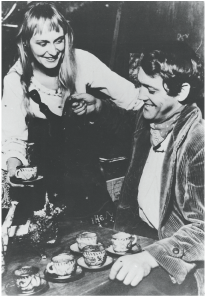
All the Boyd children helped out with the family ceramics business from an early age, and David was no exception. He studied music (he was a gifted pianist) and (briefly) painting in Melbourne, before moving to Sydney during the period 1946/47, where he helped his brother Guy Boyd (who was studying sculpture at the National Art School) establish a commercial pottery. This colourful, fashionable pottery was sold under the name of ‘Martin Boyd Pottery’ and it was a highly successful venture.
In 1947, David met the precociously talented Hermia Lloyd-Jones, a student at the National Art School. They married in 1948 and spent the rest of their life together, until Hermia passed away in 2000. From the late 1940s to the early 1960s, in Australia, England and Europe, David and Hermia Boyd made commercially successful and artistically adventurous ceramics. They left Australia to live in Europe (for the second time) in 1961, just as the Australian ceramics scene was coming of age, but there is no doubt that David and Hermia Boyd were the most successful Australian ceramicists of the post-war period.
Although they continued making ceramics in England into the 1960s, David’s preoccupations had increasingly turned to painting, and his career as a potter came to a close. A full retrospective exhibition of the ceramics of David and Hermia Boyd is long overdue, and would shed a great deal of light onto a formative period of Australian ceramics.
Damon Moon
Willunga 2012
This article was published in The Journal of Australian Ceramics, Vol 51 No 1, April 2012.
Permission has been given to make it available on this website.
© The Australian Ceramics Association 2014
http://www.australianceramics.com/
Vale - Shiga Shigeo 1928-2011
With the passing of Shiga Shigeo, Australian ceramics has lost a great and long-standing friend.
There will be many tributes from those who knew him intimately, and these few words are simply to acknowledge the presence, and now the absence, of a Zen larrikin who found, at least for a time, a second home in Australia.
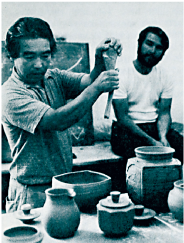
In any analysis of Australian ceramics the abiding influence of Japan is of great significance and in this singular and fascinating relationship between the two cultures the figure of Shiga is prominent. For all the hundreds of Australian potters who took the ‘Mashiko express’ in the 1960s and 70s, Shiga was one of the few took the journey in the other direction. First in Mittagong, then in Sydney, he inspired and delighted Australian potters for the thirteen years he spent in this country. Even after his return to Japan in 1980, Shiga maintained close contact with Australia and with the many Australian potters who revelled in his company.
There are many Japanese potters that have won the admiration of Australian potters, but few who came as close in spirit to this country as Shiga. From Tokyo to Terrey Hills and back again is a fair way, but it was the journey that Shiga made, and we are grateful that he did.
Damon Moon
Willunga 2011
Editor’s note: In our Archive section, pages 98-100, I have reprinted Shiga’s farewell speech (from Pottery in Australia, Vol 18, No 2, October November 1979) given at the opening of his retrospective exhibition at the Japan Foundation Centre in August 1978 just before he returned to Japan after thirteen years in Australia.
Vale - Paul Soldner 1921 – 2011
In early January 2011, Paul Soldner, one of the greats of American ceramics, passed away at his home in Claremont, California. He was eighty- nine.
Born in 1921 into a family of Midwest Mennonite Christians, Soldner’s interest in art was sparked by his wartime experiences in the army medical corps, where, to quote Jori Finkel writing of Soldner in the Los Angeles Times, he saw ... “beauty emerge from terror in the form of charcoal drawings made by Holocaust victims on the barracks walls of the Mauthausen concentration camp in Austria”.
(Frinkel, J. Los Angeles Times 4 January, 2011)
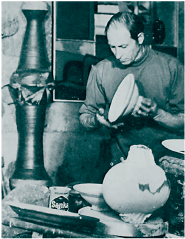
In 1954 Soldner became the first graduate student of Peter Voulkos in the newly established ceramics program at the Los Angeles County Art Institute. Like Voulkos, Soldner was given to experimentation and innovation and was also something of a showman, soon becoming what Garth Clark refers to ... “as one of the stars of the “workshop circuit”. (Clark, G. Shards, p.289)
It was during one of these workshops that Soldner famously ‘discovered’ his technique of ‘American raku’, where pots were drawn from the kiln and then ‘smoked’ in various ways to produce a range of effects much broader than those found in the original Japanese technique. But Soldner’s oeuvre extended well beyond this, encompassing a wide range of ceramic techniques and forms.
Paul Soldner was a charismatic teacher and tireless maker who came to prominence at a time and in a place when ceramics was breaking many boundaries. He continued to contribute to the development of ceramics both in the United States and on an international level throughout a long and productive life, and he will be both celebrated and missed.
Damon Moon
Willunga 2011
Perspective
“I cross the room like a dancing architect
A daddy waltz on the tops of my shoes ...”
Let’s face it – architects are cool. They wear good clothes, have distinctive taste in spectacles and build fabulous, titanium clad post-modernist cathedrals to art which rejuvenate entire cities. Even in the fraught and over-hyped world of contemporary art it’s obvious that the star attraction of the Bilbao Guggenheim is the building and its architect, Frank Gehry, and not the art inside.
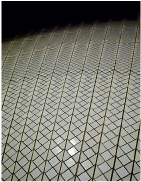
On the other hand, ceramists are not really cool and probably never have been. There may have been a certain cachet afforded to the hand-spun, tie-dyed and hirsute in the 1960s, but ceramics has really always been just this side of macramé as far as the mainstream arts establishment goes, and it probably always will be.
Given this, it might seem strange that in the early days of the post-war Australian crafts movement architects featured prominently in generating support for the crafts. They encouraged craftspeople to extend their vision by commissioning works for buildings, by helping with exhibition design, by collecting works to be shown in their own and in client’s houses, and by participating in an active dialogue as to how the built environment and the hand-made object might co-exist in the modern world.
Sydneysiders should be more aware of this than most, since they have in their midst one of the greatest examples of twentieth century architecture in the shape of the Danish architect Jorn Utzon’s Sydney Opera House, a building totally covered with white ceramic tiles. One might fairly ask if the tiles, made by the Danish firm Höganäs, are the product of craft or industry, or indeed are any more significant than the ubiquitous clay bricks from which the majority of Australian houses are constructed. But what this building represents, at least in part, is the emphatic arrival of a Scandinavian design aesthetic in Australia, and with it the promise of an integration of crafts and industry, an ideal which now probably falls into the category of ‘nice work if you can get it’ but which, nonetheless, had much currency at the time.
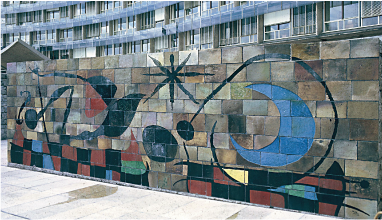

If only a few modern buildings were entirely covered with ceramic tiles – and, after all, the Muslim world had taken this technique to heights of extreme beauty and sophistication hundreds of years before – then the fifties and the sixties also saw a rebirth of interest in other ways to marry ceramics to architecture. One was in the use of mosaics, with perhaps the greatest example being Antonio Gaudi’s Guell Park in Barcelona, where the order and discipline or the traditional tiled ceramic surface is literally shattered into a colourful, fragmented universe of inspired crazy-paving.
A related use of architectural ceramics was found in feature walls or panels, which had the advantage of being able to be either outside or inside a building, due to the ability of ceramics to cope with harsh environments. The artistic partnership of the painter Joan Miro and ceramicist Jose Llorens Artigas gave us monumental outdoor panels in the 1957/59 Wall of the Sun and the Wall of the Moon for the Unesco Building in Paris, work so important that it led to Miro receiving a Guggenheim award in 1958. (Ironically, these artworks are now enclosed by a building in order to protect them from the effects of acid rain. Perhaps ceramics are not quite as durable as we think ...) Some Australian examples of public ceramics murals, as in Vincent McGrath’s three metre by eleven metre Wall, completed in 1980 for the Attorney General’s Department in Alice Springs, are mentioned in an excellent article by Romaldo

Giurgola, one of the architects of the new Australian Parliament House. This article, first published in 1984 and now reprinted in this issue of The Journal of Australian Ceramics, gives an insight into how one of this country’s leading architects sought to incorporate the work of Australian craftspeople into the very fabric of this important building (if that isn’t mixing metaphors) right from the planning stages.1
On a more intimate scale, the interiors of 1960s architect-designed modernist houses, with an emphasis on natural surfaces largely free from overt ornamentation, provide a wonderful setting for ceramics of the period. There is a certain ‘rightness’ in seeing stoneware ceramics displayed in this setting, whether as tiles, functional pottery or decorator pieces.
For example, in the ceramics of Marea Gazzard one sees a sophisticated take on the vessel as domestic sculpture. Before studying in Europe in the 1950s, Marea Gazzard, who was married to the architect Don Gazzard, had been exposed to the work of avant-garde British ceramic artists like Lucie Rie in the pages of influential architectural magazines like Domus. In England she had contact with Rie, as well as with the work of the artists Nicholas Vergette and Hans Coper, and it was Coper’s work in particular that deeply informed Gazzard’s ceramics on her return to Australia in 1960.
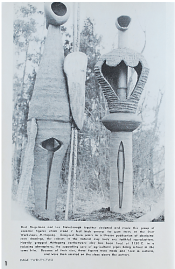
At the time, only a few Australian potters were experimenting with forms beyond the purely functional. It is true that many potters had made smaller scale sculptural pieces – John Percival’s famous Angel works are a good example – but it is a mistake to confuse this work with ceramics which have a more direct connection to architecture.
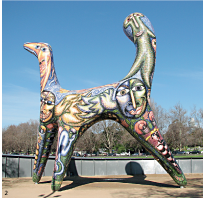
These connections are sometimes obvious, as in the incorporation of ceramics into a building or
its surrounds; at other times they are more indirect. Sometimes it is just a question of scale, as when the Austrian-born sculptor Bert Flugelman collaborated with Les Blakebrough on large scale ceramic sculptures that were made and subsequently exhibited at the Sturt Workshops in Mittagong. To pick a more contemporary example, Deborah Halpern’s well-known artwork Angel (not to be confused with the Percival ones), originally sited at the entrance to the National Gallery of Victoria and now found
at Birrarung Marr park on the banks of the Yarra River, is architectural in nature not only because of
its scale but through its intent, in that it was commissioned to be a part of a building or its immediate surrounds. This is seen quite literally in the visual pun of the sculptor Aleks Danko’s, Songs of Australia Volume 3, At Home sited in the courtyard facing the JamFactory Craft and Design Centre, the Experimental Art Foundation and the entrance to UniSA’s City West Campus in Adelaide.”
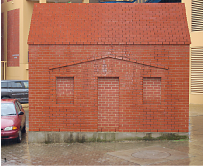
It seems likely that the emphasis has shifted in contemporary architectural ceramics in Australia, from large-scale public commissions to community-based projects. However, given the obdurate nature of the material and its intrinsic connections to the built environment, ceramics will probably always find some place in the architecture of the day.
Damon Moon
Willunga 2010
- I feel it is reasonable to claim Romaldo Guirgola as Australian since, although he was born and trained in Italy and has spent much time living in America, he took up Australian citizenship in the 1980s.
The Flying Scotsman
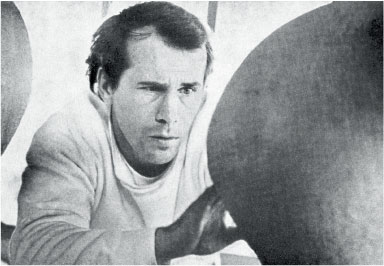
The last time Alex Leckie’s name was mentioned in dispatches, prior to news of his passing earlier this year, was in relation to the proposal in 2008 to close the ceramics department of the Glasgow School of Art.
Leckie’s name was inextricably linked to this institution. It was where he had begun studying in 1950 when, as the then Academic Registrar (Sir) Harry Barnes would later recollect, he was admitted ‘by the back door’, having shown a great deal of promise but possessing none of the normal qualifications to gain entry.1
It is unsurprising that the young Alex Leckie didn’t take to the disciplines of the post-war British education system, given his rather idiosyncratic upbringing. His father was an ardent communist and political activist who, nonetheless, instilled an appreciation of the arts into his son. The Leckie household library was extensive, containing several thousand books, and there were visits to art galleries and museums where he developed his appreciation of the work of ancient cultures, echoes of which would be found in his own ceramics in later years.
Leckie excelled at art school and was offered the chance to complete a Post-Graduate Diploma. A figurative vessel that was exhibited in that graduation exhibition is illustrated here, and demonstrates both his command of the medium and a remarkably early adoption of what would later become recognisable as his mature style.
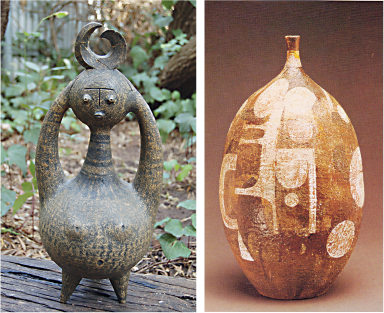
In 1955, and in imminent danger of being called up for National Service, Leckie decided to move to Australia. Having relatives in South Australia he settled in Adelaide where he soon found employment throwing garden pots at Bennetts Magill Pottery, a job which he would later describe as providing ‘good discipline’.2 Enquiries at the South Australian School of Art led him to discover that he was the most highly qualified potter in South Australia, a situation which, rather ironically given his background, led to him being employed in 1956 as a teacher of ‘pottery and sculpture’.
It’s worth pausing at this stage to place Alex Leckie in the context of the early world of post-war Australian ceramics. When Leckie arrived in Australia, Ivan McMeekin, Ivan Englund, Peter Rushforth and Mollie Douglas were just establishing the Potters’ Society of NSW, Gwyn John (Hanssen Pigott) was still apprenticed to McMeekin at Sturt, Carl McConnell was active in Brisbane, Henri Le Grand was teaching in Canberra, Harold Hughan and members of the Boyd clan were taking their varying approaches to ceramics in Victoria, and there certainly were others – but not that many.
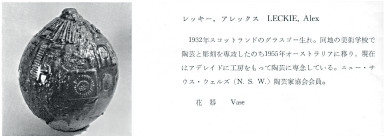
Considering where to place Leckie in this field is an interesting exercise. For a start, he was not a single-minded devotee of the Anglo Oriental approach espoused by Leach and Cardew, instead showing a preference for a modernist, European sensibility which brings to mind Picasso’s anthropomorphic ceramics. But Leckie also didn’t favour the rather commercial, high-keyed palette of earthenware, his surfaces instead relying on the subdued colours of clays and ochres, albeit enlivened by his use of colour and a marvellously dexterous feel for line and modelling. His ceramics refer back to the archaic forms which inspired him in his youth, where man and beast, male and female, entwine and merge in a sensuous dance with the medium of clay.
For all his undoubted technical and artistic abilities and a myriad of friends and supporters within the arts community, Leckie’s rebellious nature ensured that his tenure within the South Australian education department would not be without problems.
The by now well-known episode of Leckie swimming naked in the River Torrens and of his subsequent arrest (a seemingly trifling incident which provided front page titillation for the tabloid press and ultimately led to Leckie’s dismissal from his teaching post in 1962), introduced a surprisingly productive period during which he exhibited widely, undertaking many important commissions and becoming President of the Contemporary Art Society of South Australia. In 1964, he was one of three Australian ceramicists chosen to represent this country in the International Ceramics Exhibition in Tokyo, with his work, Destroyed City also appearing on the cover of Pottery in Australia. 3 4
In 1966, Alex Leckie decided to return to Britain. He spent a short time in London at the Central School of Art before returning to Scotland, where he was appointed Head of Ceramics at the Glasgow School of Art in 1968, a position he held for the next twenty years.
In an obituary published in The Scotsman, Jimmie Macgregor wrote that Alex Leckie ‘ ... took a moribund ceramics department by the scruff of the neck, completely transforming it and turning out students who were a credit to the school.’5

In all fairness, the Glasgow School of Art probably deserves considerable credit for keeping Leckie on staff for twenty years, as this ‘... wee bull who caused havoc in many a china shop ...’6 would certainly find difficulty adapting to today’s more politically correct academic setting. No more would a whole pig be roasted in the kiln as a contribution to Activities Week, but perhaps the managerial class which now largely controls the directions of art schools, on either side of the world, will doubtless rest easier at night.
When he left this country in 1966, Leckie was as well-credentialled as anyone, exhibiting nationally in prestigious galleries, working on architectural commissions and, above all, selling large amounts of his work to an appreciative public, all of which he achieved by the age of 35. He left behind many admirers, fond memories, some scandalous tales and an engaging and highly accomplished body of work. It is
to be hoped that an opportunity might exist in the not too distant future for the current generation of Australian ceramicists to be able to see a comprehensive exhibition of the work of Alex Leckie.
Damon Moon
Willunga 2010
- ‘Alex Leckie Ceramics’, an essay by Sir Harry Jefferson Barnes accompanying an exhibition at the St Enoch Exhibition Centre, Glasgow Museum and Art Gallery.
- Ceramics in South Australia 1836 – 1986; from folk to studio pottery, Noris Ioannou
- Destroyed City by Alex Leckie, cover image, Pottery in Australia, Vol.3 No.2., October, 1964.
- In the end, four Australian potters were included in the International Exhibition of Ceramic Art in Tokyo – Alex Leckie, Milton Moon and Bernard Sahm were chosen by the various Australian selectors, whilst the Canberra-based potter Cecily Gibson was included following her extended residency in Japan.
- Appreciation: Alex Leckie, Jimmie Macgregor, The Scotsman, 12 February 2010
- ibid
